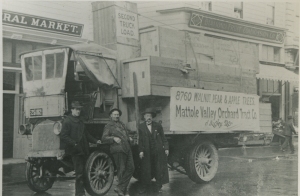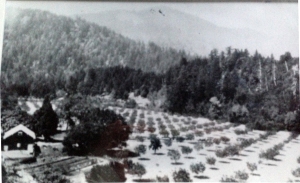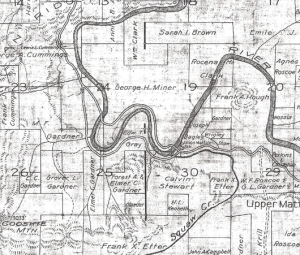Union Mattole, Squaw Creek, New Jerusalem… all designations of the mid-lower Mattole area favored by perfectly warm weather and clear skies all summer, lacking the harder frosts and snow of winters further inland as well as the cooler ocean effects, and occasional fog, of the mild Petrolia summers. In short, an agricultural paradise.

Photo taken in Eureka, found in the Mary Rackliff Etter collection. Click on this and other photos here to enlarge.
The picture above, of a truck carrying fruit trees to the Joseph Bagley orchard, seemed a good starting point for an introductory exploration of the apple business in this area of the 1910s and ’20s. Bagley’s original orchard covered land presently owned by the Yonts and the Burroughs families.
Luckily, the MVHS has a wonderful document compiled by Susie Van Kirk, a Humboldt-area historic resources consultant, called “MATTOLE RIVER: Newspaper references from the Mattole River Watershed.” I called Ms. Van Kirk some time back and asked if i might quote from her collection and she generously said “Of course,” since the text is all from local newspapers anyway; but she sure saved me a bunch of work! So, a big “Thank you” to Susie Van Kirk.
Around 1907, rumors began appearing of a wharf near the mouth of the Mattole River, mainly for the shipping of tanbark (since it was being promised by tanbark bigwigs Calvin Stewart and Thomas Johnson, previously involved in that business in the Fort Bragg and Needle Rock wharf areas)– but also anticipated as a route to world markets for Mattole dairy products, livestock, and fruit. The Ferndale Enterprise of Oct. 29, 1907, reads, “Mr. Stewart of Needle Rock and his son Horace arrived in Upper Mattole Tuesday evening, the former on business connected with the projected landing… Mattole people are very enthusiastic concerning the wharf which it is now nearly certain that Messrs. Stewart and Johnson will build next summer. Many years have the people of the Mattole valley waited for something of this kind, and in the meantime for the lack of an outlet have seen the community go backward instead of forward… Our ranchers are still busy hauling apples.”
The Nov. 1 Enterprise of that year goes on about the “… good and substantial promise of the building of a wharf and the construction of a railroad by Messrs. Stewart and Johnson of Bear Harbor, in order to ship from this valley and the surrounding hills the vast quantities of tanbark found thereon which has been growing there many years to swell that particular industry…. No one can regard this matter as idle gossip, for the promoters of this enterprise mean business and are men of their word. It is one of the greatest opportunities this community can ever expect, so it stands every property owner in hand to boost the proposition and help it on with their shoulders to the wheel for its earliest construction and completion. For what does it mean to all? Why, it means a cheaper and more rapid way of marketing your beef, orchard and farm produce and thus increase their production and make such industries profitable ones. It will bring ten people here where there is only one now, and all this means more work, more money in circulation, cheaper living than that of today…. and you should not forget that it will give the oil companies a chance to bring their operating machinery here and land it almost upon the fields of proposed operation, and what better prospects of prosperity could anyone ask than the creating of such an industry as oil mining…” Well! Probably oil would have been more profitable than apples. But you can eat the apples!
Many more newspaper references to the promise of the wharf appear in the next few years, mainly in the Ferndale paper. By March 3, 1908, the fruit market comes up again: “Our people now think the landing a certainty and it is hard to estimate what this may mean to the Mattole. For this valley is not like the little communities further south, where, when the bark is exhausted, there is nothing left to support a landing. We have the capacity to raise apples equal to those of Hood River and with the same care in cultivation, spraying and packing, ought to be able to gain the same reputation and command the same price.” An entry unrelated to the wharf confirms this (April 30, 1909): “Prosperity at Mattole–Frank K. Howard of Upper Mattole came up to Ferndale… [He] said that the fruit crop in the Mattole section this season promises to be the most successful one in many years… Mr. Howard himself has over six acres of fruit-bearing land now under cultivation… Last year he put in a dam and irrigation ditch, the latter running about a quarter of a mile from Wood creek. Mr. Howard has over 4000 strawberry plants set out, thirty different kinds, and over 1000 blackberry plants, as well as seventy-five peach trees…”
The Roscoes were avid apple-growers. Ken Roscoe has a couple of pages on the Valley’s apples in his book Heydays in Humboldt, which i highly recommend to Mattole history lovers. I can’t resist including this little story, though: “When I was nine years old, I picked a select box of King apples off a tree from the ‘King of Tompkins Company, New York,’ and another box of Baldwins and sent them to the Panama Pacific Exposition, the 1915 World’s Fair in San Francisco. I said nothing about being nine years old and won the Blue Ribbon on each. Possibly on the strength of that showing, we sold King apples to the Palace Hotel in San Francisco for many years at a remarkable price for those times.” (p. 120.)
Back to the newspaper references, we find on Dec. 21, 1909, that “Fred Roscoe, who has been in San Francisco for several weeks, having been in charge of the shipment of Mattole apples, returned to his home last evening. Mr. Roscoe was very enthusiastic concerning the future of the apple industry in Mattole, although the venture of last Fall was not especially successful, owing to the fact that many boxes reached the city in badly damaged condition due to having gotten wet and other causes for which the growers were not responsible. The apples that reached the city in good condition brought a good price…”
In 1909 the wharf was up and running. The Mattole Lumber Company, the Stewarts, the railroad, the wharf, and the tanbark business are together a daunting topic and should be addressed another time. Pertinent to the apple subject, I believe that the promise of the wharf led those with already existing orchards to focus on, or expand, their production capabilities, and caused others to plant fruit trees, which led to the apple boom of the late 1910s and ’20s. Let’s skip to the Ferndale Enterprise of Dec. 23, 1913: “Mr. Joe Bagley has been making another visit to his property here. The logging donkey that was used in the operations of the old Kelsey mill is now busily engaged in pulling stumps, and soon, where there was once a tangle of brush, there will be orderly rows of young fruit trees. According to rumors, there will eventually be a greatly increased population in the Mattole valley, especially in the summer, as it is said that numerous small tracts of land are being sold to outside people, who intend to set out either nuts or apples, and erect summer homes…”
“W.E. Roscoe has received an order for 4000 trees, apple, pear, and walnut, to be grafted this spring. Mr. Bagley will specialize on the Jonathan apple, which he believes to be best adapted to the Mattole valley, an opinion that is shared by some Mattole orchardists…” was the news of Jan. 6, 1914.
And next, on Feb. 13, 1914, comes the information for the picture above (though i didn’t realize this until i typed it!): “Ten Thousand Trees for Mattole Ranch–Last Tuesday and Wednesday there arrived in Ferndale by auto truck from Eureka 8760 walnut, almond, peach, apple, pear, cherry, and plum trees, as well as a large variety of grape vines for the Mattole Orchard Company of Upper Mattole. Later other shipments will follow, bringing the total number up to more than ten thousand. Four, four-horse teams were required to take the trees from Ferndale to Mattole, two of which left yesterday and the others will go today.
“Joseph Bagley of Eureka is the manager of the Mattole Orchard Co…. Mr. Bagley some time ago purchased the Kelsey ranch and another place or two at Mattole, his holdings there being approximately one thousand acres. Several Eureka men are associated with him on the project. … Mr. Bagley had Farm Adviser Christiansen, Prof. B.H. Crocheron and other soil experts visit the land. Upon their judgment and from other evidence, it was determined that the land would grow to perfection walnuts, pears, apples, peaches, plums and other fruits and nuts, and also grapes…. It was determined to bring the land to a full state of development, and to this end men have been employed in clearing up and making improvements to the property in preparation for setting out an immense orchard. Twelve men are at present at work there and twenty will be employed while the trees are being planted… The Mattole is aptly termed the garden spot of the world and it has no more enthusiastic booster than Mr. Bagley, who is backing up his faith with hard cash…”
Another scheme to produce more fruit and more Mattole residents was proposed on March 20, 1914: “The new development work will be on the ranch of 320 acres at Upper Mattole belonging to Mr. and Mrs. D.A. Francis of Ferndale…. The land will be subdivided into tracts to suit purchasers from five acres up. Mr. Francis is to clear the land where necessary, set out the varieties of trees specified by the purchaser, care for them four years, and at the end of that time deliver a deed for the land to the buyer. In this way, the non-resident purchaser will be relieved of the care of the young orchard and is assured of having a well-growing lot of trees on his land when he takes possession. It is anticipated that there will be a lively demand for small acreages with a growing orchard thereon…”
A month later, April 30, 1915, the Enterprise reports that “Joseph Bagley, manager of the Mattole Valley Orchard Tract Company, recently made an extended tour through the southern part of the state, where he visited famous orchard sections and upon his return he is more than ever convinced that the Mattole country is the best in the state… [the MVOTC] has nearly 200 acres of land set out to walnuts and fruit at present, and is steadily increasing this area.”

The old Bagley orchard, looking southwest toward Cooskie Mtn. Thanks to Linda Yonts for sharing this photograph.
We do not see Mr. Bagley’s name mentioned much after this. He was also involved in many other Mattole ventures, including extensive walnut tree plantings, 150 acres of beans, a sawmill (probably the one that had been Sam Kelsey’s), and in 1918, 25 or 30 acres of peas. His apple dream appeared to be materializing, although he didn’t seem to be around to enjoy it. (I can’t find much, in a quick search, of his personal life, but he does appear to be living in Eureka up until at least 1932.)
Although by then the Mattole wharf was no longer functioning, having been smashed repeatedly by winter storms, many of the Mattole orchards were just coming into their own. Joseph Barksdull noted in the March 28, 1919, Ferndale Enterprise that the completion of the Bull Creek Road, planned for the coming summer, promised renewed economic activity for the Mattole. Mr. Barksdull “is planting out a large acreage to various orchard fruits and his neighbors are following suit. Enough fruit is being raised there to afford a profitable run for a good sized cannery and apple dryer, another factory which will add to the prosperity of the Mattole valley.” By Aug. 22 that need is answered: “Messrs. Elphic and Lyman, who are building the apple dryer… state that they expect to employ about ten girls during the drying season.” Oct. 3, 1919: “The dryer is now running, but has not yet a full crew of helpers. It is the intention of Elphic and Lyman to dry 40 tons of apples this year.” Nov. 21, 1919: “Mr. Mullen is hauling out the dried apples with Mr. Elphic’s truck as fast as they are dried. They are shipped from Dyerville.” (I suppose this means the apples boarded the train south at Dyerville, over where the South Fork meets the main fork of the Eel?)
Elphic appears in Ken Roscoe’s book as Jim Elphick of Sebastopol. Ken assigns him the responsibility of having carried in coddling moths on apple sacks he brought up from the south, unwittingly no doubt. They spread all over the Valley and necessitated the spraying of arsenate of lead, which may have negatively impacted the health of the soil from that point on. However, he says the Mattole continued to produce good apples, and that a problem more pressing than the moths now would be the modern apple maggot. I’ve noticed that bears can take quite a liking to apples, too!
Dr. Harry Perkins showed up as a sugar daddy to the Valley. I’m not sure if he financed the dryer that Lyman and Elphic were using, or if there were two, but there is a lengthy and admiring article about him in the Jan. 2, 1920 paper. “To him is due the credit of securing a sawmill and apple dryer, both of which were financed by outside capital and located on the place owned by the doctor [a fifty-acre ranch in Upper Mattole]. Dr. Perkins stated that [the apple dryer] filled a long-felt want in the community. Practically the entire apple crop of Union and Upper Mattole, with the exception of the extra choice apples which were shipped to the Eureka and San Francisco markets, was put through the dryer, several hundred tons having been cured by the process. Practically all of these apples in past years went to waste. Their preservation this year not only adds greatly to the food supply of the country, but has resulted in the distribution of many thousands of dollars to wage earners and growers throughout southern Humboldt. At times during the rush season, the dryer provided employment for as high as 40 workers.”
However, Ken Roscoe says in Heydays in Humboldt that around 1924 “Elphick’s apple dryer burned down, so we built one on our property and had no trouble getting the apples we needed to keep it in full operation. It took about eight pounds of fresh apples to produce one pound of dried apples. The dryer was profitable, and we operated it for many years. Young people in the valley could have gone into that business in recent years and made a success of it, if they had the ambition and did not have a much easier way to make a living. ” (His book was published in 1991.)
Albert Etter was in Ettersburg at this time, but his attention didn’t turn to apples, with spectacular results, until the late twenties. For many people, his name comes up immediately when one mentions Mattole apples–particularly his popular Pink Pearl and Waltana varieties. There are a couple of issues of our MVHS newsletter, Now… and Then, with stories on Etter and his fruit, one by Ram Fishman and one by yours truly.
An earlier passionate apple-growing family was the Gardners of the Union Mattole neighborhood.

1921 Belcher’s map section. Note Bagley’s orchard property to the east of the right-hand stroke of the “W” in the river. Gardners are all around, and Dr. Perkins’ place is on the far right of the map, which also begins Roscoe country.
Millard F. Gardner is mentioned in the Sept. 14, 1894, Enterprise as “M.F. Gardner, our Populist friend of Union Mattole, was up Saturday on his way to Singley Station [train stop near Fernbridge] with a wagon load of Hungarian prunes and crab-apples of the General Grant and Van Dyke varieties, intended for the Eureka market. This fruit was grown on the places of Mr. Gardner and Geo. Hill and was of the very finest quality… Mr. Gardner has a fine place in Union Mattole and is rapidly improving it, and he can grow as fine fruit there as can be raised anywhere in the state. He hopes to make a market for his products and we earnestly hope he succeeds.”

A generation later (not sure of the date), M.F. Gardner’s son Grover Gardner was shipping crates with this label. Note the misspelled apple name–you never could get anything to be perfect…
Note that there will be an Apple Festival at the Mattole Valley Community Center this Sunday, October 20, 2013, from 11 ’til 4. All are welcome… let me know if you want more information. But don’t let it stop you from coming down to the Mattole Valley Historical Society meeting at the Mattole Grange just after the Pancake Breakfast the same day… from noon until 2 at the latest, we will discuss the Mattole estuary and beach with old-timer Erwin Frederickson and BLM employee Gina Jorgensen. Hope to see many of you there… and off to the apple celebration afterward!

